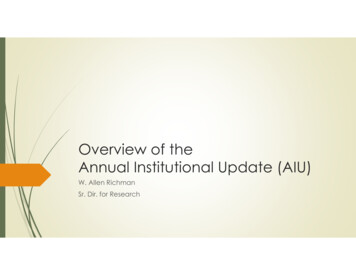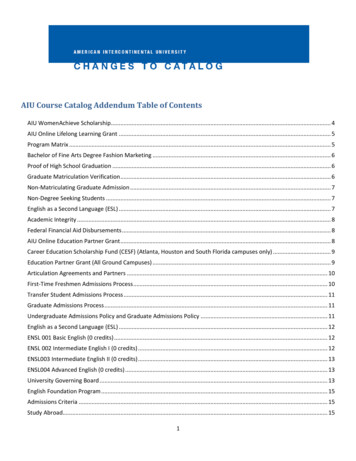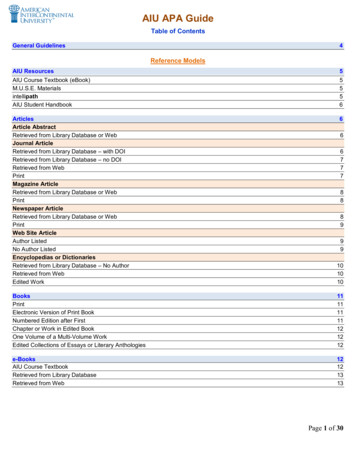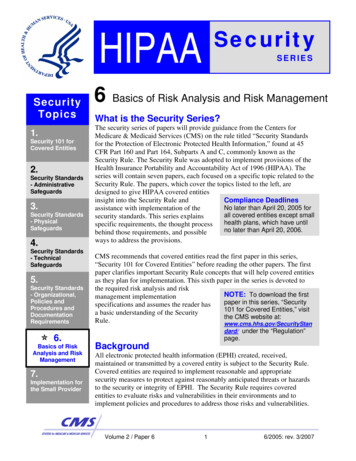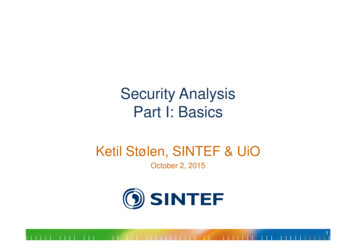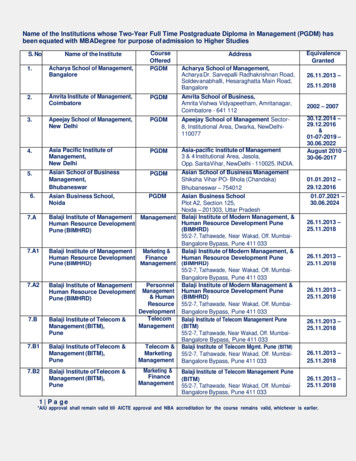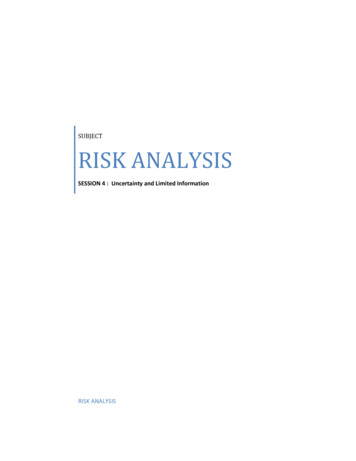
Transcription
SUBJECTRISK ANALYSISSESSION 4 : Uncertainty and Limited InformationRISK ANALYSIS
RISK ANALYSISSESSION 4 : Uncertainty and Limited InformationOverview of Risk ReportingTo provide visibility of risks and progress in mitigating them, the followingreports should be distributed on a regular basis as part of the normalproject status reporting system:Table 1 - Risk Reporting SectionsTITLELEVELDESCRIPTIONRisk Watch ListOrganization &ProjectLists risks to facilitate monitoring risksand initiating risk responses.Risk MitigationPlanOrganization &ProjectLists avoidance/mitigation actions, ifand when risks occur.Risk ProfileProjectDisplays planned, actual andprojected progress in reducing risks.Management Contribution to Risk ManagementThe keys to effective risk resolution are early identification,communication, and risk management. All issues and risks must beidentified and recorded in one place for easy reference by every projectteam member. Every user and team member must be aware ofoutstanding issues and accept ownership for their existence (and possibleresolution). Finally, the Project Manager must manage and control theissues through an established documented procedure.The Project Manager must use a structured approach to resolving issuesand problems. By clearly defining the underlying problem (root cause),by identifying alternative solutions, and by objectively evaluating theconsequences, the Project Manager can minimize adverse effects on theproject. Three (3) major issue types are relevant to the any major project:1
Business, Technical, and Team.The project stakeholders review the business and technical issues while theteam issues remain internal to the project team. When defining andresolving technical issues, priority is a factor. Prioritization of technicalissues is handled using a 1-5 scale.Resolving issues is an ongoing process that occurs throughout the lifecycle of any project. Expect, however, that some issues cannot beresolved within the scope of a project. Still, theProject Manager should identify those issues that cannot be resolved anddevelop action plans to resolve them at a later time.When resolving issues, a priority should be assigned to help determine theappropriate resolution. Low, medium, high, and emergency can beassigned to issues associated with the project.Risk Management ResponseRisk management alternatives include either:1. Risk avoidance,2. Transfer / sharing of risk (insurance),3. Prevent the risk, or4. Develop a risk mitigation and / or contingency plan.Mitigation of Global RisksThe cost / benefit and funding requirements of both potential andencountered risks should be documented in the finalized businessrequirements.Appropriate measures should be taken to protect each parties’ interestsincorporated in contractual arrangements. This will be achieved through2
the project Statement of Work (SOW) or Document of Understanding(DOU).Mitigation of Scope Related RisksThe scope of a project should be completely defined to help avoidinadvertent requirements’ omissions, errors, and misunderstandings viaStatements of Work and the Project Management Plan. Management isexpected to honor its commitments and to provide the necessaryresources required to have a positive and timely outcome. There must bewell-defined and enforced acceptance requirements in order to have asuccessful outcome.Mitigation of Timeline-Related RisksThere must be specific support in providing resources outside of theimmediate development group via internal / external contractagreements and coordination with organization management. Everyonemust agree to multiple phases of a project in order to achieve short-termobjectives.Mitigation of Cost-Related RisksThe financial situation must continue to be assessed and justified, basedon up-to-date business case and economic evaluations. All costs shouldbe reviewed with the section responsible for funding the softwaredevelopment effort.Mitigation of Quality/Performance RisksAcceptance criteria and quality and technical performance criteria (asdefined by the requirements and state standards) must be documented.Any State performance standard must be followed under a client/serverproject.3
2. Risk Management Process GuidelinesIdentify RisksIdentifying specific risks is occasionally a precarious task. Not all risks canbe identified or mitigated contiguously. In this section, you will need toconcentrate on identifying underlying problems, based on visiblesymptoms. Symptoms are often the only indication of an underlyingproject problem or issue. Many symptoms act as a facade to the realproblem. The Project Manager must isolate the actual risk and to filter outthe symptoms to identify the root cause.Note:There is no shortcut to identifying problems. Experience, communication,and intuition assist the Project Manager in getting to the "root cause of therisk, problem, or issue."The general risk management process to be followed begins withreviewing the planning documents that specify the project including: Deliverables and work processes, Milestones and schedule dates, Resource estimates/needs/sources, and Performance requirements.Talk with appropriate stakeholders and other experts to develop acomprehensive list of potential risks. This process may include: Getting the right people involved, Staff meetings, Gathering business requirements, Analytical sessions, Scheduling user community meetings, or Conducting a Kulik and Lazarus high-level project assessment.4
Risks or potential risks will also be identified by observation through: Management staff interaction, and “Reading” personnel actions and reactions.Potential Areas of RiskTable 2 - Areas of Potential ZATIONPROJECTDatabaseSoftwareProject SizeSystemsKnowledgeContractorFull TimeStability ofOrganizationContractorFull gePropensityTransitionalTimeStability ofUserOrganizationProblemSolvingSkillsProgrammin ical SeniorSkillsManagementCommitmentTools or Aids Quality ofAvailableInformationClientLevel ulnerabilityto ChangeReadinessforTakeoverMainframeStability ofBusinessNeedDesignCommitParticipa menttionto TeamCLIENTAvailabilityof ChampionStaffContinuedAvailabilit nceSkillsAchievementDriveCharge-back ExperienceSystemwith Users5
ONPROJECTTestingResourceIntensity ojectStandardsUsedExperiencewithApplicationPCs orDesktopsOrganizationalImpactLevel ofCommitmentStaffTurnoverAccountabilit Experienceywithfor herAvailability riencewithProjectTeamReliability ofPersonnelConversionDifficultyAcceptSize ationTime FrameSignoff/approvalprocessEstimatingSkillsStaff onSkillsPossibilityofTurnoverClassify Risks by Type6
Categorize risks along the lines shown in a risk classification document(table 4), to aid in subsequent determination of risk controllability andselection of appropriate risk mitigation actions.Assess RisksStep 1:Assess the likelihood of occurrence (probability of occurrence)by eliminating any risks which, on reflection, you believe will notoccur. Roughly classify the remaining risks as high, medium, orlow probability of occurrence.Step 2:Assess the severity of impact by: Evaluating each risk in terms of its possible impact on theproject baselines of effort, cost, time (schedule), andrequirements (scope, performance, acceptance, quality) Eliminating any risks which you believe have no or onlytrivial impact on the baselines Roughly classifying the remaining risks as high, medium, orlow severity of impact.Step 3:Prioritize the identified risks on the basis of the rough assessments.The contributing factors are the likelihood of occurrence andseverity of impact.Step 4:Quantify the risk based on probability by assigning numericalvalues to various aspects of each risk to provide a consistentbasis for combining them into an overall Risk Profile anddetermining risk mitigation opportunities and actions. Assign avalue from “1” to “5” to each risk (based on the likelihood ofoccurrence) using the scale below:Table 3 - Scaling Risk7
ASSESSMENT OFLIKELIHOODStep 5:VALUESCALEVery unlikely1Somewhat unlikely250/50 chance3Highly likely4Nearly certain5Quantify the risk (based on severity of impact) using the tablebelow:Table 4 - Assessment of Risk SeverityASSESSMENT OF SEVERITYMinor impactperformanceStep 6:onVALUEschedule,1Moderate impact on cost, ery significant impact on projectbaselines4Disastrous impact, probable projectfailure5impactcost,onQuantify the risk (in terms of level of controllability) using thetable below:8
Table 5 - Risk Controllability AssessmentASSESSMENT OF CONTROLLABILITYStep 7:VALUEEssentially avoidable through selected riskmitigation actions1Highly controllable through organization orproject actions2Moderately controllable through organizationor project actions3Largely uncontrollable by the organization orthe project4Uncontrollable by the organization or theproject5Determine risk mitigation actions. Identify and record potentialactions that could be taken in order to avoid or mitigate theindividual risks (based on their level of controllability) using thetable below:9
Table 6 - Risk Controllability RatingCONTROLLABILITYRATINGTYPE OF MITIGATION1 or 2Actionswhichshouldbeimmediatelyincorporated into the project managementplan3 or 4Actions which should be documented ascontingent risk responses to be incorporated inthe project management plan in the event ofthe risk occurring5None.By definition, such risks cannot beavoided or mitigatedCaution: The above guidelines are suggestive, not hard and fast. On anygiven risk, for example, it may be possible to identify actions, which shouldbe immediately incorporated into the project to partially reduce the risk,as well as actions that should be treated as contingent risk responses. Riskclassification may also change during the system development life cycle.For any risks on which multiple, alternative responses were identified,evaluate the responses and select the preferred ones. If time is limited,consider performing only the following: Avoidance or mitigation actions to be immediately included in theproject management plans Decomposition of the selected risk responses into their constituentwork tasks (the level of detail should be consistent with that used toplan the work in the Project Schedule) Estimating the resources needed to perform the risk mitigation andscheduling the detailed work activities including: Modifying the Project Schedule for actions that are to beincorporated immediately Determining activity duration (not specific schedule dates) forcontingent risk responses10
Note:Incorporating these actions may impact the project baselines.Step 8:Prepare a Risk Watch List that summarizes the results of the risksthat have been identified. All of the information needed toprepare this document is available (as a result of the precedingwork), except that assessment must be made of the target datesfor reduction of each risk. Input all of the risk information on theriskreport.xls spreadsheet. Making these assessments requiresreference to the project schedule to determine when the workassociated with the risk is scheduled to be performed.Step 9:Develop a Baseline Risk Profile. Calculate a Significance Levelrating for each risk by summing its ratings for Likelihood ofOccurrence and Severity of Impact. Construct an originalBaseline Risk Profile by plotting a curve based on the summationof the risk Significance Levels, considering the target dates forreducing each risk by 50% and in total.Step 10: Monitor Risk Status. As work is performed, monitor and assess: Progress in reducing risk (e.g., completion of work thatachieves the targets of 50% and total risk reduction) Occurrence of risks that call for initiation of contingent riskresponses Effectiveness of implemented risk reduction and riskmitigation actions and any needs to modify these actions.Step 11: Maintain a Risk Watch List. Update the Risk Watch List to reflectthe results of monitoring risk status. Also reflect the effect of anyproject change requests.Step 12: Maintain a Risk Profile. Update the risk profile to reflect thecurrent risk status. This involves the plotting of curves to reflect:11
Actual progress in reducing risks Revised risk reduction baseline, considering actualprogress, new risks identified, and effects of change ordersand re-planning changes.Step 13: Report Risk Status. The Risk Watch List is issued as a regularcomponent of the standard monthly project performancereporting packages (e.g., status reports, project plan milestones,Gantt charts).Risk Mitigation PlanThis section defines the actions that need to be taken in order to reduceor eliminate the impact of risks on the project or on individual functions. ARisk Mitigation Plan is done during initial project analysis and planning.Maintain it in connection with the project execution. This process is alsoutilized in connection with the detailed project planning activities and isupdated (as needed) in subsequent cycles of re-planning. It is applicableto all projects and can be applied to ongoing functions of the projectmanagement office when relevant.Risk Mitigation GuidelinesRisks can arise from any aspect of a project.Thus, a completeidentification of all project risks can only be obtained by involving asufficient number of people to ensure that in-depth competence andexperience is applied to the process for all significant aspects of theproject scope.Some project risks can be identified by simply deducing the definedproject risks that are applicable to the project. It may be necessary torestate these risks in the context of the project scope. Other project risks12
can only be identified by carefully analyzing the project managementplan, project schedule and requirements.Some of the risk mitigation actions can be incorporated into the ProjectManagement Plan in conjunction with detailed project planning activities.Other risk mitigation actions represent contingency plans to beimplemented only if the risk actually occurs.A secondary use of the Risk Mitigation Plan occurs if and whenimplemented risk responses do not prove effective. When this happens,the Risk Mitigation Plan provides information on other, alternative riskresponses that should be reconsidered for implementation.Recording Risk MitigationTable 7 - Risk Mitigation Table is self-explanatory, except as follows:1. Category - Project Management normally specifies the standardcategories of risks. The categories that will be used are found in Table1;2. Object - The object, task, phase, or activity (at the project level) towhich the risk applies;3. Severity - A subjectively assigned numerical rating from low to high ofthe expected level of impact on the project if the risk occurs (see Table4 - Assessment of Risk Severity);4. Alternative responses - Detailed plans (or cross-references to attacheddetailed plans) that specify the alternative sets of actions that can betaken to avoid or mitigate the identified risks;5. Rank of Response - The preferred ranking of the alternative responsesstarting at “1” (most preferred). Refer to Table 8 for detaileddescriptions of control rank responses;6. Response Taken - “Contingent” is entered if the response is only to beacted upon, when the risk occurs;7. Assign responsibility - Assign the risk to the appropriate individual. Thisdoes not need to be tracked in the “Suggested Risk Mitigation Table”but may be included in the Comments section and must be includedin the project schedule with the associated resources.13
8. Comments / Closure - All risks need to come to a conclusion, even ifthat conclusion is “no action taken”. Risks requiring a “developed”solution will be reflected in the project schedule.A suggested Risk Mitigation Table format is defined in Table 9.Table 7 - Risk Mitigation Table ontimeSeverityImpactAreaAlternativ Rank of ResponeRespons seresponses eTakenCommentsClosure4CallReceptionWait toexistingsystemRisk ProfileThe Risk Profile graphically portrays the project’s exposure to risk. It showsthe planned, projected (if different from plan), and actual risk reductionachieved as the project progresses. The Risk Profile is created from the RiskWatch List.14
Risk ime NowRelease ICompleteRelease IICompleteRelease IIICompleteTIMEFigure 5 - Graphical Risk ProfileRisk Profile GuidelinesThe Risk Profile risk reduction curves are determined as follows:Step 1:An overall numerical measure is established for each risk.Typically, this is computed by multiplying the Estimated Level ofImpact Rating times Level of Confidence Rating where: The Level of Impact Rating is a number that represents theseverity of the impact if the risk occurs. The Level of Confidence Rating is a number thatrepresents the expected probability that the risk will occur.Step 2:Dates are established representing the times when each risk isplanned to be reduced (first by 50% and then in total).Step 3:The values for these measures are reduced as progress is madein reducing the risks.15
Step 4:The results of the above calculations are summed for the projectby time period (usually months), taking into consideration: Planned Risk Reduction, to derive the planned risk profile Achieved Risk Reduction, to derive the actual risk profile Projected Risk Reduction, to extrapolate a projected riskprofile (if actual varies significantly from plan).One option is to show two planned risk reduction curves, the original plan,and the current or revised plan. Attached, as Appendix C is a detailed listof references for additional risk management research.Risk Watch ListA risk watch list is a list of current risks that typically shows type of risk, levelof impact, importance, ways of identifying and handling the risk, timeframe for risk reduction, responsibility for management of the risk.Risk Watch GuidelinesOne option is to include a rating for each risk that is a combination of theLevel of Impact and Level of Confidence ratings.Another option is to identify and include in this Section “Risk Triggers”,which are symptoms to watch for that signal potential or actualoccurrence of the risk.A simple scheme should be used to quantify risks. The quantificationprocess is somewhat subjective, regardless of the method used to assignthe numerical values. Using a more complex quantification scheme willprobably not do much to reduce this inherent subjectivity.Consideration should be given to devising a scheme for quantifying theimpact of joint occurrence of multiple, closely related risks. The effect ofsuch occurrences may be much more significant than is implied by simplysumming their individual values. The likelihood of such occurrences isusually calculated by multiplying the individual risks’ estimated probabilityof occurrence by each other. The usual handling of joint risks is:16
To combine them and reassess the resulting, more global risk To define an additional risk described as a joint occurrence risk andassess it in terms of the incremental impact of the joint occurrenceover and above that of the individual risks.Consideration should also be given to relating each risk to thecorresponding level of Project planing. This will prove helpful in keepingmanagement attention to each risk at an appropriate level of detail.Risk Watch Required ElementsThe typical data shown in Table 8 - Suggested Risk Watch List, is selfexplanatory, except as follows:1. Risk Category - Type of risk, based on standard categories establishedby Project Management. One typical categorization scheme is: Financial - Almost everything results in cost. Limit these entries toestimating errors, budget effecting overruns. Resource – Most application development efforts involve the useand availability of people and skills. Schedule - Anything that directly affects the schedule as definedin the Project Schedule (e.g. estimating/scheduling errors,resource availability problems, and overruns). Technical - Anything that is directly related to the technologychosen to provide a solution (e.g. requirements complexityand/or changes, immature technology, integration problems). Management – Project management skills or organizationalmanagement focus and commitment are essential elements ofall software development efforts. Communication – The inability to understand user requirementsand avoid project surprises are key project success measures. Operational - Implementation problems due to conflicts, poortraining, physical resource unavailability. Political – Effect on the citizens and citizen services.17
Organizational - Events outside the project such as marketplacedevelopments, regulatory changes and strategy changes.2. Related Work - When applicable, a cross-reference to the work thatgives rise to the risk. In a project-level document, it will normally be adeliverable associated with the risk.3. Risk Response - A summary statement of the risk response(s) which ispreferred or which has been initiated. Note that the details of theresponse are spelled out in the Risk Mitigation Plan.4. Level of Impact, Level of Confidence, Level of Control - Judgmentallyassigned numerical ratings of the expected severity of the effect,estimated probability of occurrence, and expected ability to controleach of the identified risks. Any number scale can be used, but a 3point scale (i.e. "1" to "3") is usually sufficient and does not imply anundue level of precision.5. Date to Reduce by 50% and Completion Date - These dates show therisk reduction targets for management control purposes. They alsoprovide the data needed to plot the time axis of the Risk Profile.Risk Watch List Suggested FormatTable 8 - Suggested Risk Watch List IHOODSIGNIFICANCE(SEVERITY notdeliveredon pending18
TechnicalCannotsupportMobileCom alphapaging;interactive softwaredoes notrun underUNIXBuild an eRequestpending19
20
Minor impact on cost, schedule, performance 1 Moderate impact on cost, schedule, performance 2 Significant impact on project baselines 3 Very significant impact on project baselines 4 Disastrous impact, probable project failure 5 Step 6: Quantify the risk (in terms of level of controllability) using the table below:
